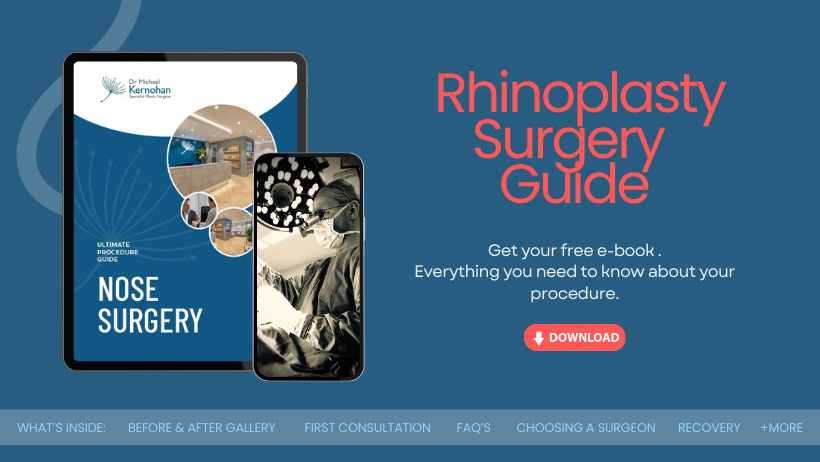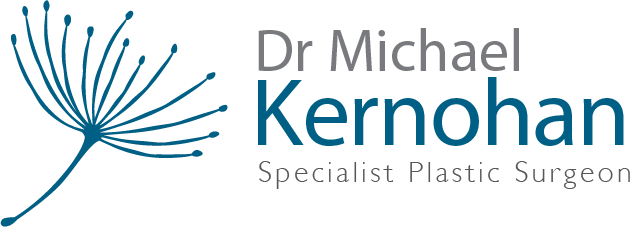Surgical and Non-Surgical Options For Different Nose Shapes
Whether you’re seeking a surgical option like rhinoplasty or a non-surgical alternative such as liquid Rhinoplasty, there are ways to alter the contour of your nose. Before discussing different procedures for nose reshaping, it’s essential to understand the various nose shapes and how they contribute to your facial symmetry. Nose shapes include aquiline, bulbous, flat, hooked, snub, and more. Each shape has its unique characteristics, which can either complement or detract from your overall appearance. The goal of cosmetic procedures is to harmonise your nose shape with your other facial features for a balanced look.
Specialist Plastic Surgeon Dr Michael Kernohan combines aesthetics with functionality in his surgical approach. His patients seek him out not only for cosmetic ability but also for increased nasal function. By addressing issues such as a deviated septum or enlarged turbinates, Dr Kernohan’s rhinoplasty procedures often lead to increased ability to breathe allowing patients to enjoy a wide range of activities without discomfort or hindrance.
Take the Quiz
Common Nose Abnormalities and Their Effects on Appearance
Nose abnormalities can range from subtle to more noticeable, and they can impact the harmony of your facial features. Some common nose abnormalities include:
- Deviated septum: This occurs when the cartilage that separates your nostrils is off-centre, leading to breathing difficulties and an asymmetric appearance
- Nasal hump: A bump on the bridge of the nose can result from genetics or injury, creating a less streamlined profile
- Wide nostrils: Nostrils that are wider than average can make the nose appear larger and less refined
- Bulbous tip: A rounded, bulbous tip can lead to a less defined and disproportionate nose shape
- Hooked nose: A downward curve at the tip of the nose can lead to an aged or unbalanced appearance
These abnormalities can contribute to dissatisfaction with one’s appearance. It’s important to know that there are options available to address these concerns and help you achieve a more harmonious and balanced look.
Rhinoplasty: The Surgical Solution for Refining Nose Shapes
Rhinoplasty is a surgical procedure that can alter the nose shape and change the appearance of the nose. It involves reshaping the bone, cartilage, and soft tissues of the nose to achieve a more balanced and symmetrical look. Rhinoplasty can address issues such as a deviated septum, nasal hump, wide nostrils, bulbous tip, and hooked nose.
During a rhinoplasty, your plastic surgeon will make an incision either inside your nostrils (closed rhinoplasty) or across the columella, the tissue between your nostrils (open rhinoplasty). they will then reshape your nose’s underlying structure to create the desired contour. The procedure takes 1 to 3 hours, and you’ll likely need at least 1-2 weeks off work for recovery.
Rhinoplasty can provide significant long-lasting, results, but it is a complex procedure that requires a skilled surgeon and a thorough understanding of your desired outcome. It’s essential to research your surgeon’s qualifications, view their before-and-after photos, and communicate your goals clearly during your consultation to achieve the best results possible.
Liquid Rhinoplasty: A Non-Surgical Alternative for Nose Contouring
For those who are not ready for a surgical procedure or want a less invasive option, liquid rhinoplasty might be the right choice. This non-surgical treatment involves the use of volumising treatments, into specific areas of the nose to achieve a more balanced shape. Liquid rhinoplasty can address issues such as a small nasal hump, a flat nasal bridge, or a slightly asymmetric nose.
The procedure often takes about 30 minutes, and the results can last up to two years, depending on the type of treatment used. There is not a long recovery associated with liquid rhinoplasty as it is not classified as invasive surgery and you can usually return to your daily activities shortly after the treatment.
While liquid rhinoplasty offers a more accessible and temporary solution compared to surgical rhinoplasty, it’s essential to choose an experienced injector to optimise results. Keep in mind that liquid rhinoplasty has limitations, and it might not be suitable for addressing more severe abnormalities or achieving dramatic changes in nose shape.
Download Dr Michael Kernohan’s Rhinoplasty Guide

Analysing Different Nose Shapes
Each nose shape has unique characteristics, and the right approach will vary depending on your specific features. Here’s a brief analysis of different nose shapes and the contouring goals for each:
- Aquiline nose: Characterised by a prominent bridge and a slightly downward-curving tip. The right contour approach aims to reduce the prominence of the bridge and refine the tip for a more balanced appearance
- Bulbous nose: Features a rounded, bulbous tip and wide nostrils. The goal for this approach is to alter the tip to increase definition and narrow the nostrils.
- Flat nose: A low nasal bridge and wide nostrils define this nose shape. The approach for this type of nose seeks to add height to the bridge and narrow the nostrils for a more proportionate appearance
- Hooked nose: With a downward curve at the tip, the goal for this nose shape is to lift and straighten the tip for a more balanced appearance
- Snub nose: Characterised by a short, upturned tip and a small nasal bridge. The surgery aims to add length and height to the bridge and refine the tip for a more proportionate look
Tips for Contouring Various Nose Shapes
When it comes to contouring your nose, whether through makeup or cosmetic procedures, there are some tips to keep in mind for various nose shapes:
- Aquiline nose: Focus on reducing the prominence of the nasal bridge by applying contouring makeup or treatments to smooth and even appearance
- Bulbous nose: Use contouring techniques to create the illusion of a narrower, more defined tip and slimmer nostrils
- Flat nose: Add height to your nasal bridge with contouring makeup or volumising treatments and consider narrowing your nostrils for a more defined appearance
- Hooked nose: Lift and straighten your nose tip using contouring techniques or volumising treatments to create a more balanced appearance
- Snub nose: Create the illusion of a longer nasal bridge by applying contouring makeup or volumising treatments to the tip for a more proportionate look
It’s important to remember that contouring makeup can only do so much, and for more significant changes, cosmetic procedures may be necessary.
Choosing the Right Procedure: Surgical Vs. Non-Surgical Solutions
When it comes to nose contouring, the decision between surgical and non-surgical options depends on your desired outcome, budget, and personal preferences. Here are some key factors to consider when choosing between the two:
- Results: Surgical rhinoplasty provides more dramatic and long-lasting results than liquid rhinoplasty
- Cost: Liquid rhinoplasty is generally less expensive than surgical rhinoplasty, making it a more accessible option for those on a budget
- Downtime: Surgical rhinoplasty requires more downtime for recovery than liquid rhinoplasty
- Limitations: Liquid rhinoplasty has limitations and is not suitable for addressing more severe nose abnormalities or achieving significant changes in nose shape
Preparing For Nose Surgery
If you’ve decided to undergo nose surgery, it’s essential to be prepared. Here are some general guidelines about what to expect for nose surgery:
- Consultation: Schedule a consultation with a specialist plastic surgeon to discuss your desired outcome, medical history, and any questions or concerns you may have
- Preparation: Your plastic surgeon will provide specific instructions on how to prepare for the procedure, such as avoiding certain medications and supplements
- Procedure: The procedure itself takes 1 to 3 hours, depending on the complexity of each case
- Recovery: Depending on the specifics of the procedure, you may need to take time off work and avoid strenuous activity for several weeks to allow for proper healing
- Follow-up: Follow-up appointments with your plastic surgeon or injector will be necessary to optimise results
It’s essential to follow your plastic surgeon’s instructions carefully and communicate any concerns or questions you may have during the process. By understanding your nose shape, identifying any abnormalities, and analysing your specific features, you may be able to can achieve a more harmonious facial appearance.
FAQs about Nose Shapes and Rhinoplasty
What ethnicity has small noses?
- There is no specific ethnicity that has universally small noses, as physical features can vary greatly within any ethnic group. However, some East Asian populations, such as those from China, Japan, and Korea, tend to have smaller and flatter noses compared to other ethnicities. It is important to recognise that these are general observations and not definitive characteristics, as individual variations are always present.
Is a small nose more feminine?
- A small nose is not inherently more feminine, as perceptions of attractiveness and gender traits can be subjective and influenced by cultural norms. While certain cultures may associate a smaller nose with femininity, others may not make such distinctions. What is considered feminine or masculine can vary greatly depending on individual preferences and societal expectations.
How many cm is a big nose?
- There is no specific measurement that defines a “big nose,” as the perception of what constitutes a large nose can be subjective and influenced by various factors, such as face shape, cultural norms, and personal preferences.
Will my nose change after 18?
- It is common for the nose to continue to change and develop until the late teens or early twenties. While most of the growth occurs during adolescence, some subtle changes can still happen after the age of 18. Factors such as genetics, hormones, and even environmental influences can contribute to the final shape and size of your nose.
Does rhinoplasty change your nose shape?
- Rhinoplasty is a surgical procedure that can indeed change the shape of your nose. The surgery can be performed to alter the size, shape, or proportions of the nose, address breathing difficulties, or correct deformities resulting from injury or a birth defect. The specific changes to the nose’s shape will depend on the patient’s desired outcome and the plastic surgeon’s recommendations based on the individual’s facial structure and aesthetic goals.
Further Reading about Nose Surgery with Dr Kernohan
- Read Dr Kernohan’s Rhinoplasty Surgery Page
- Read Dr Kernohan’s Tip Rhinoplasty Surgery Page
- Read Dr Kernohan’s Blog about How to Make Your Nose Smaller
- Read Dr Kernohan’s Blog about Broken Nose Surgery – Break Your Nose?
- Read Dr Kernohan’s Blog about Cartilage Graft Nose
- Read Dr Kernohan’s blog about Will Medicare Cover My Nose Surgery/ Rhinoplasty?









